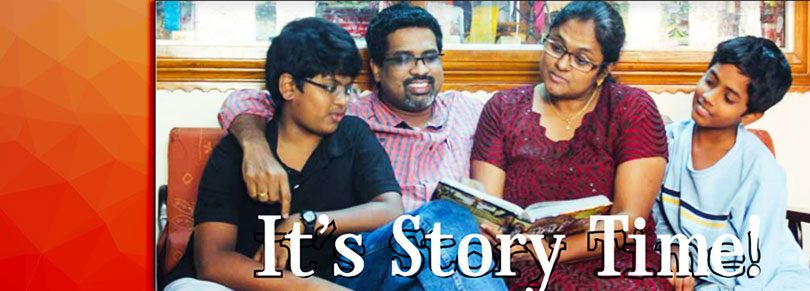“Who loves stories?” All the hands went up. “Who hates stories?” Not one hand rose up; wait, in the corner, near the cupboard a boy, big for his age, slowly put up his right hand. Now I moved closer to him and asked him if he would like to say why! The boy looked me over with his little eyes and then uttered these words – “Well, I don’t hate all stories – just the ones that are told in a boring way, and maybe the ones that always try to point out my mistakes… hmm…wait…wait, also the ones in which I have no role to play” Then I said, “I can see that you really love good stories and probably have more than a few of them to share – am I right?” A reluctant grin came over the boy, and he nodded his head affirmatively. A boy sitting further away blurted out, “Narain always has a story to share Uncle!” Then another and many more raised their voices as testimony to this little big boy. If you had looked at my face then, you would have seen a big smile of joy written large across my face. All this happened at a summer camp where I was invited to equip children with skills to perform stories.
One of the needs of families is quality family time – a time where both parents and children come together to have joyful fun and build values. (And this definitely cannot be gained by all sitting before the ‘idiot box’ as a family). The world to the children of today is a big splash of color synchronized with right sounds all presented as powerful stories in television, movies, youtube etc – the result is a dilution in their attention span when it comes to listening. For parents, ungluing the children from these media magnets and teaching them to listen better, requires an interesting family time. The answer I have found is Story-time. Now when we read or tell a story, simple or complicated we are in direct competition to the great media around us. The solution is to tell stories that have the children involved right from the beginning. In other words, we need to guide our children up the ladder of storytelling – starting from story listening to story performing. I am going to reveal to you three steps on this.
This is the first step and so as we read or tell a story, it’s important that the children are allowed to interact with it. How? Get the children to choose the characters (you can have some control over this by keeping the main character(s) as your choice); choose the type of characters – animals, objects, people, fairies, monsters, superheroes, movie characters, Biblical characters etc; choose the setting – where the story unravels; choose the moral of the story (this requires some dialogue beforehand to clearly spell out the moral being presented); allow the children to interact – they can draw characters and color; sketch the setting; play music if they are learning an instrument; produce a background sound; act out a character; speak certain repetitive sayings – like saying a certain set of words after each point in the flow of the story. These are few of the many aspects and you can mix and match, also innovate to create your own style for each story telling session. This not only brings out the story in full color and sound, but makes the experience good for you too.
This is the next step and here the child / children are given the opportunity to actually contribute to the flow of the story. Everyone sits in a circle and one person who is the story- director starts the story. (He/she also has the final say on the flow, moral, message etc). Initially the child can be prompted to add story-bits by asking them questions that lead to the right answers; then the child can be given a time limit (say 30 seconds) to add to the story (you can establish boundaries beforehand, so the story does not go off in a tangent or into unchartered territory). The players can also stand up and act out the story. Story sharing happens in a circle and you can keep it fast or slow moving and as the story passes on, the sharing becomes creative. The child / next person in the circle can add sentences, songs, sounds, non-verbal actions etc. Remember as the story-director you have the privilege of wrapping up the story and giving everyone applause or maybe a star in the story-participation chart. One tip – remember to fix a time-limit and if the story is not complete – take it to the next day. Start with the summary of yesterday’s, then continue the sharing.
The third step involves you letting the child have the bigger chunk of the storytelling process. Just like us, children collect incidents from their lives and when they are given opportunities to link that with values they gain valuable experiences, which are guiding points in their journey. Now, how do we help them discover the connections without actually thrusting it into their minds? By helping the children craft it as stories and performing the same. The process begins with us, the parents not just listening actively to the flow of incidents but also capturing the same through rapid sketches, clarifying questions and understanding voices. Once we have one story captured, we need to start building it. This is called Story-crafting. The basis is this – every story should have a beginning, middle and an end – with a clear association to a value. (If you want to learn more about story-crafting, I suggest going through a good book on storytelling). This crafting is a collaborative process – the child needs to be totally involved. He needs to know why this flow is better, why this sequence makes sense when performing, the need for intonations, non-verbal gestures and actions etc. Do remember to have lots of fun when crafting – that teaches the child the beauty of working with joy and enthusiasm. Once you have a clear storyline – help the child perform it. Allow him to change words or structures, add his own style of gesture, emotion and have a blast telling the story to you and to others. Find ways to celebrate this achievement and make this a weekend activity.
Remember, stories are the fabric of our life and if children can be trained in this – they become better listeners, better communicators, collaborative and participative workers. So this New Year, carve out a family time and rediscover the joy of delighting together with your children. Happy Story-time!






canadian pharmacycanadian pharmacy https://www.bakespace.com/members/profile/Canadian drugs online pharmacies/1563583/
Fine facts. Thank you.
canadian prescriptions online https://canadianpharmaceuticalsonlinee.bandcamp.com/track/canadian-pharmaceuticals-usa
Regards. Numerous postings!
pharmacy https://www.isixsigma.com/members/pharmacyonlinenoprescription/
You mentioned that really well.
Tadalafil https://www.goodreads.com/user/show/161146330-canadianpharmaceuticalsonline
You’ve made your stand pretty clearly.!
online canadian pharmacies https://fliphtml5.com/homepage/fhrha
Incredible lots of superb knowledge!
canadian prescriptions online https://www.mixcloud.com/canadianpharmaceuticalsonline/
Superb postings. Thanks.
online canadian pharmacies https://bitbucket.org/canadianpharmaceuticalsonline/workspace/snippets/k7KRy4
Regards, A lot of data.
canada medication https://www.midi.org/forum/profile/96944-pharmacyonlinecheap
You reported it wonderfully.
canada drugs https://pharmacycheapnoprescription.nethouse.ru/
Kudos. Fantastic information.
canadian pharmacy https://my.desktopnexus.com/Canadianpharmacygeneric/journal/
Terrific facts. Thank you.
canadian drug https://wakelet.com/@OnlinepharmacyCanadausa
Thank you, Loads of material!
canadian pharmacies without an rx https://forum.melanoma.org/user/canadadrugsonline/profile/
Fantastic posts. Thank you!
canadian pharcharmy online https://disqus.com/by/canadiandrugspharmacy/about/
Tips very well utilized!.
canadian pharmacies online prescriptions https://halttancentnin.livejournal.com/301.html
Thanks, Numerous write ups.
Canadian Pharmacies Shipping to USA https://graph.org/Canadian-pharmacies-online-12-11
You actually mentioned it really well!
drugs for sale https://www.buymeacoffee.com/pharmaceuticals
Regards. I enjoy this!
canadian pharmaceuticals online https://canadianpharmaceuticalsonline.gger.jp/archives/18015248.html
Great posts. Thanks a lot!
ed drugs list https://wallsawadar.zombeek.cz/
Awesome write ups. Cheers.
erectile pills https://piesapalbe.estranky.sk/clanky/buy-erectile-dysfunction-medications-online.html
Regards. Fantastic information.
best erectile dysfunction drug https://plancaticam.estranky.cz/clanky/best-drugs-for-ed.html
You made your point!
erectile enhancement pills https://challonge.com/afersparun
Amazing content, Thank you.
canadian pharmacycanadian pharmacy https://scisevitrid.estranky.sk/clanky/canada-pharmacies.html
You’ve made your stand quite clearly!.
prescription drugs without prior prescription https://challonge.com/townsiglutep
Terrific posts. Appreciate it.
global pharmacy canada https://pinshape.com/users/2513487-online-medicine-shopping
Kudos! I enjoy it!
canadian pharmacy world https://suppdentcanchurch.estranky.cz/clanky/online-medicine-order-discount.html
Good content. Thank you.
canada online pharmacy https://canadianpharmaceuticalsonline.eventsmart.com/2022/11/20/canadian-pharmaceuticals-for-usa-sales/
Truly lots of excellent data.
Tadalafil https://sway.office.com/bwqoJDkPTZku0kFA
Wow a lot of very good data.
canada pharmacies online https://canadianpharmaceuticalsonline.tawk.help/article/canadian-pharmacies-shipping-to-usa
Many thanks, I appreciate this!
Tadalafil 5mg https://challonge.com/ebocivid
Thanks a lot! Quite a lot of facts!
Tadalafil tablets https://pinshape.com/users/2510246-medicine-online-shopping
You reported that adequately.
Tadalafil tablets https://aoc.stamford.edu/profile/uxertodo/
Wow a good deal of fantastic facts.
canadian government approved pharmacies https://speedopoflet.estranky.sk/clanky/international-pharmacy.html
Thank you! I like it.
canadian pharmacy online 24 https://sacajegi.estranky.cz/clanky/online-medicine-shopping.html
Valuable data. Thanks.
canada drugs online https://challonge.com/ebtortety
Wonderful data. Regards.
canadian pharmacy online 24 https://aoc.stamford.edu/profile/upogunem/
Thanks a lot! Ample stuff!
canadian online pharmacy https://infogram.com/canadian-pharmacies-shipping-to-usa-1h1749v1jry1q6z
Thanks a lot. Numerous forum posts.
canada online pharmacy https://medium.com/@pharmaceuticalsonline/canadian-pharmaceutical-drugstore-2503e21730a5
You actually expressed it well!
online canadian pharmacy https://dragonballwiki.net/forum/canadian-pharmaceuticals-online-safe/
Nicely put, Cheers.
canadian pharmacy uk delivery https://pharmaceuticals.cgsociety.org/jvcc/canadian-pharmaceuti
Thanks a lot, An abundance of data!
canadian pharmacy online 24 https://demo.socialengine.com/blogs/2403/1227/canadian-pharmaceuticals-online
You mentioned it superbly.
stromectol doses https://orderstromectoloverthecounter.fo.team/
Very good write ups. Regards.
ivermectin dosage https://graph.org/Order-Stromectol-over-the-counter-10-29-2
Many thanks. Terrific information.
stromectol effectiveness https://telegra.ph/Order-Stromectol-over-the-counter-10-29
Effectively spoken really! .
stromectol overdose https://orderstromectoloverthecounter.flazio.com/
You reported it wonderfully!
stromectol cvs https://buystromectol.livejournal.com/421.html
Good facts. Cheers.
stromectol mites https://orderstromectoloverthecounter.mystrikingly.com/
Valuable advice. Appreciate it.
Tadalafil https://tropkefacon.estranky.sk/clanky/buy-ivermectin-fitndance.html
Nicely put. Kudos!
buy stromectol uk https://pinshape.com/users/2491694-buy-stromectol-fitndance
You actually suggested that superbly.
best canadian mail order pharmacies https://www.infospace.com/serp?q=“My Canadian Pharmacy – Extensive Assortment of Medications – 2022”
You said that adequately!
prescription drugs without prior prescription
Thank you. Useful stuff!
canada drug https://www.bakespace.com/members/profile/Сanadian pharmaceuticals for usa sales/1541108/
Useful tips. Thanks a lot!
canadian government approved pharmacies
Whoa tons of useful facts.
ivermectina dosis https://sanangelolive.com/members/unsafiri
This is nicely put. !
northwestpharmacy https://www.mojomarketplace.com/user/Canadianpharmaceuticalsonline-EkugcJDMYH
Terrific data. Many thanks.
canadianpharmacy https://www.ecosia.org/search?q=“My Canadian Pharmacy – Extensive Assortment of Medications – 2022”
You actually said it fantastically.
canada drugs online https://legalmarketplace.alanet.org/profile/421920/0
Thanks! Loads of tips.
canadian pharmacies online https://wefbuyersguide.wef.org/profile/421914/0
Very good stuff. Kudos!
dose for stromectol https://dsdgbvda.zombeek.cz/
Thanks a lot, An abundance of information.
stromectol over the counter https://soncheebarxu.estranky.cz/clanky/stromectol-for-head-lice.html
Nicely put. With thanks.
Tadalafil 20 mg https://challonge.com/citlitigolf
You revealed it wonderfully.
canada pharmacy online https://experiment.com/users/canadianpharmacy
Nicely voiced truly. !
global pharmacy canada https://haikudeck.com/canadian-pharmaceuticals-online-personal-presentation-827506e003
Kudos, I like it!
canada drugs online https://500px.com/p/bersavahi/?view=groups
Wonderful posts, Thanks a lot.
All written, posted, and descriptions. All are beautiful. so I will be really happy when I visit here.
My male boss scolded me because I didn’t do a good job. I was sad that day because I had done a lot before going to work. then he won’t be able to appreciate everything I did. I lost all my sadness when I saw your site, it’s so beautiful and amazing.
https://main7.net/thenine/
stromectol biam https://pinshape.com/users/2462910-order-stromectol-online
Whoa a good deal of good data!
stromectol espana https://pinshape.com/users/2462760-order-stromectol-over-the-counter
Lovely data. Many thanks.
Tadalafil https://pinshape.com/users/2461310-canadian-pharmacies-shipping-to-usa
Kudos. I enjoy this.
best canadian pharmacies online https://aoc.stamford.edu/profile/hispennbackwin/
You said this effectively!
ivermectina dosis https://web904.com/stromectol-buy/
Really a good deal of terrific data!
dose of stromectol https://canadajobscenter.com/author/arpreparof1989/
You have made your stand pretty nicely..
ivermectine https://www.repairanswers.net/question/order-stromectol-over-the-counter-2/
You said it perfectly!
order stromectol over the counter https://www.provenexpert.com/order-stromectol-over-the-counter12/
Appreciate it, A good amount of stuff.
stromectol price https://orderstromectoloverthecounter.bandcamp.com/releases
Thank you! Terrific stuff!
stromectol headache https://ktqt.ftu.edu.vn/en/question list/order-stromectol-over-the-counter-10/
Cheers. An abundance of advice.
stromectol for scabies https://aoc.stamford.edu/profile/Stromectol/
Thanks! Numerous content!